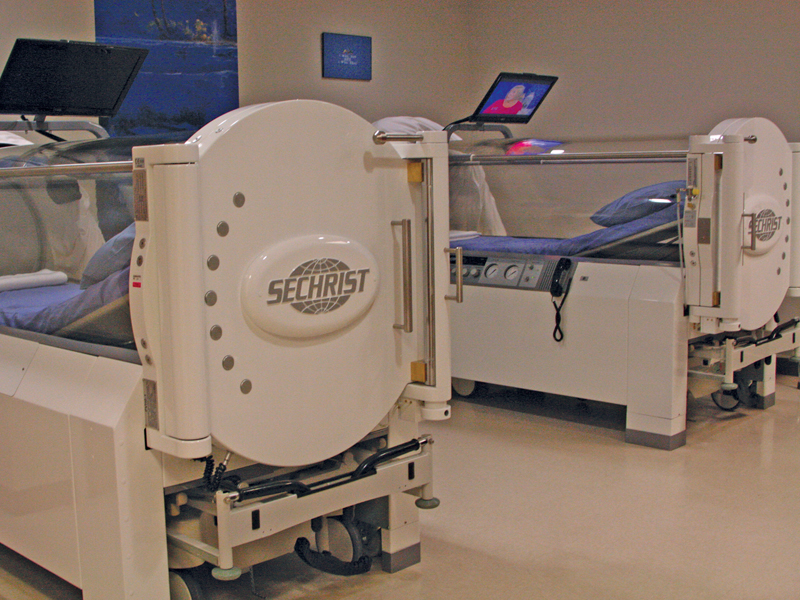On one wall at the Sentara wound Healing Center in Williamsburg, Virginia, are several “healing trees,” each covered with green paper leaves bearing the photos of patients who have been healed.
Anthony Merriman isn’t there—yet. But he hopes to be one day. The 51-year-old Williamsburg resident has been visiting since December to get care for a stubborn wound that resulted from treating his colon cancer. He’s also one of about two dozen people who have used the center’s revolutionary hyperbaric oxygen therapy tanks.
The center opened in September 2011 on the Sentara Williamsburg Regional Medical Center campus as a place to treat wounds that need extra care. More than 1,000 patients have since visited the team of doctors, nurses and technicians who are specially trained to care for wounds. In just a few years, the center has won several awards for clinical excellence.
Last September, the center added two hyperbaric oxygen therapy chambers as treatment options. These chambers represent the latest in wound care, allowing pure oxygen to saturate a patient’s blood in order to encourage faster healing of stubborn wounds.
“Wound care is changing, just like health care,” says Brian Landry, the center’s program director. “You’ve got to be constantly on top of the latest treatments.”
Wound care can be a tricky business, requiring time, precision and often times a strong stomach. But it is needed—more than 7 million Americans suffer from chronic wounds, according to the National Institutes of Health (NIH), with more than 1 million new cases a year.
A 2010 NIH study called chronic wounds a rapidly growing threat to public health and the economy, with billions spent annually on treatment because of increasing health care costs, an aging population and a rise in diabetes and obesity.
Chronic wounds are rarely seen in the healthy, the NIH says, but in those who suffer from other issues. Fifteen percent of all diabetics develop chronic wounds, with some 70,000 diabetics requiring amputation each year. Places like the Wound Healing Center try to help avoid surgery through intense, specialized treatment of stubborn wounds.
At the Williamsburg center, they see it all. Wounds resulting from diabetes and venous ulcers—wounds that appear when leg veins don’t return blood to the heart correctly—are among the types seen, along with pressure, surgical and traumatic wounds, burns, and sores from radiation treatment.
“Many people come in and have been dealing with a wound for a long time,” says Dr. Lisa Cash, one of the physicians on staff. “They don’t know what to do.”
The center is adding a seventh physician to its medical team this summer. All the physicians practice elsewhere in the community, alternating days that they visit the Williamsburg center. The doctors come from a variety of specialties, including podiatry, internal, family and emergency medicine. The entire staff is specially trained.
“We have the advanced knowledge of the treatment of the wound, and the products to get that wound healed,” says Kathy Loonam, a registered nurse and the center’s clinical coordinator.
Patients are often referred to the center by their physicians, but about a quarter of those come in by word-of-mouth. Treatment is not quick—it takes weekly visits, with the staff treating more than just wounds, but the patients as well, making sure they are taking care of themselves at home, or have the help they need. The average wound patient visits the center eight to nine times over several months before being discharged and getting a leaf on the healing tree.
More stubborn wounds are sometimes marked for hyperbaric oxygen therapy, which requires patients to spend about two hours a day in treatment for about 40 weeks. Treatment involves lying inside a clear, pressurized, sealed chamber while pure oxygen is pumped in. The treatment works at a microcellular level, forcing oxygen into cells to make wounds heal faster.
Merriman turned to hyperbaric oxygen therapy after repeated operations on a wound on his buttocks, which was caused when he was treated for colon cancer in 2007. The abscess just would not heal, causing infection to come back time and again.
After treatment in the oxygen chamber, the wound closed, but Merriman still requires care because of a lingering infection. He visits the center every other week, calling the staff there “excellent.”
“Everybody there is unbelievable, very personable,” Merriman says. “We joke; we laugh. It seems like they go the extra mile to make you feel comfortable.”
And one day, Merriman hopes to be another leaf on the healing tree.
The Sentara Wound Healing Center can be reached at 757-345-4550.



